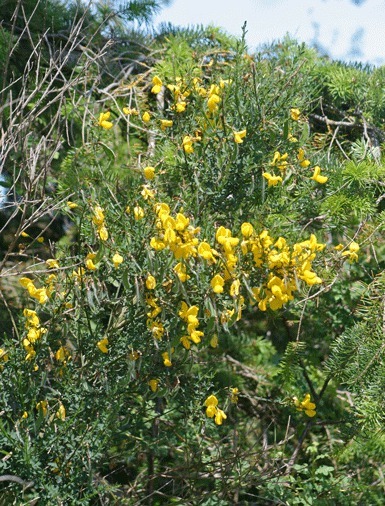By San Juan County Noxius Weed Control Program Staff
It’s a banner year for Scotch broom (Cytisus scoparius).
Throughout the county, the bright chrome-yellow flowers of this invasive shrub festoon roadsides and meadows. For many years broom was widely planted throughout the Northwest as a soil stabilizer and ornamental landscape plant. Its success, however, has proven a curse.
It has naturalized — established itself — in a wide variety of habitats, including pastures, meadows, open forests, roadsides and seasonally dry washes. As the seeds are easily spread by animals — even by ants — logging machinery, land-clearing activities, and soil transport, broom has become the most prominent invasive weed in our county, crowding out native plants and preventing the regeneration of native trees such as Garry oaks and big-leaf maples.
As a nitrogen fixer, broom out-competes most native shrubs that have evolved in our nitrogen-poor soils. The broom invasion has become so severe that the Washington State Department of Agriculture has banned the sale and importation of the species (including all of its many cultivars), and the state Noxious Weed Control Board has designated it as a Class B noxious weed.
That means that in San Juan County, a landowner is legally obligated to keep the species from spreading.
Control can be achieved by uprooting the plants with a weed wrench, cutting them at the base before the seed pods ripen, or applying herbicides. In areas of high conservation value, such as Garry oak woodlands, cutting the mature plants at ground level has proven to be the most effective technique, as it minimizes regrowth and soil disturbance, thus bringing fewer seeds to the surface where they can germinate.
Cutting is most effective when the shrubs are drought-stressed and their energy is sapped by flower production, but before the seeds are ripe. Studies have shown that plants more than one-half inch in butt-diameter have little ability to stump sprout.
In disturbed areas of lower conservation value, such as roadsides, a combination of cutting and pulling is effective. During the wetter winter and spring months when the soil is moist, seedlings may be pulled by hand. Larger plants should be tackled with a weed wrench. When using this tool, care must be taken to minimize soil disturbance and trampling of native vegetation.
Later in summer and in early, fall when the soil is drier, cutting becomes more effective and less damaging to the environment.
Herbicides containing glyphosate or triclopyr can be effective when used carefully, depending on the location. The most effective technique is to dab a small amount of herbicide on freshly cut stub cut early in the season. Timing is critical, however, and the herbicide must be applied immediately upon cutting.
San Juan County regulations prohibit the use of herbicides on any public right-of-way. Always follow the label instruction when using any herbicide. The label is law.
Prevention of seed production is critical to any weed control. Removal of plants by cutting or pulling before they set seed is the first step. In order to slow the spread of broom, always remove isolated plants first, and then work from the margins of an infestation towards the center.
In all cases, follow-up treatment on a yearly basis is essential. Scotch broom seeds can survive up to 80 years, and young plants start to produce seed in their second year. Specialists can be hired to help with removal on your property.
— For more information on Scotch broom or other noxious weeds, or to find out how to borrow a weed wrench, contact the San Juan County Noxious Weed Control Program at 376-3499, or by email at rich@sanjuanweeds.org or judy@sanjuanweeds.org.



